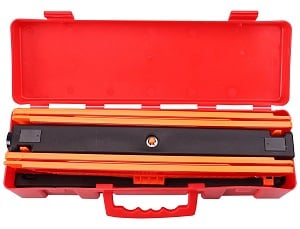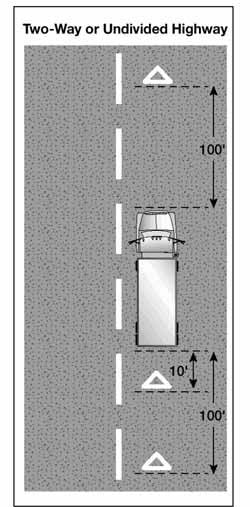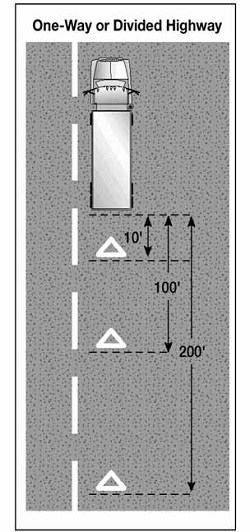
DOT reflective are mandatory in all commercial vehicles. It’s inevitable that at some point in your truck driving career you are going to break down, it happens to all commercial drivers sooner or later.
You need to be prepared with DOT reflective triangles and know how to arrange them so that you can protect yourself and others sharing the road with you.
DOT (Department of Transportation) approved warning devices are required on all commercial buses, trucks, and truck tractors. If you drive a commercial vehicle you need to have emergency reflective triangles or road flares with you at all times in the event of an emergency. The best DOT triangles (link to Amazon) are made by Cartman. They are the highest quality reflective triangles out there and they come with a nice case to store them in. In this article you will learn everything you could ever want to know about DOT reflective triangles and how to safely arrange them.
Do You Have To Have DOT Approved Reflective Triangles?
Yes, you do. The FMCSA (Federal Motor Carrier Safety Administration) has made it mandatory that you have must have warning devices for stopped vehicles with you at all times. You can choose to have three reflective triangles, six fusees, or three liquid burning flares. The reflective triangles are the best option because they are easy to store and are low maintenance.
What To Look For When Buying Reflective Triangles
When buying reflective triangles there are a few things that you need to look for. This is a list of the three things you should be on the lookout for.
Are They DOT Approved?
It is important that the emergency reflective triangles that the ones you buy are DOT (Department of Transportation) approved.
If you are unsure you should email the seller or the manufacturer to find out. The emergency triangles are usually marked or stamped as being DOT approved.

Do They Come With A Storage Case?
When buying emergency triangles make sure that they come with a case. Nothing worse than losing a triangle and not realizing it until you need to use them or your truck is inspected. Plastic cases that have a latch of some kind are best.
Make Sure You Are Getting Three Triangles
The DOT requires you to carry three emergency reflective triangles. Its actually nearly impossible to find DOT approved triangles in anything other than sets of three but you might come across some one Ebay that only have one or two triangles. Regardless of how cheap the price is you shouldn’t buy them. If you need a nice set of triangles that have a case, three triangles, and are DOT approved I recommend these Cartman triangles.
How To Set Up Emergency Triangles
How and when to setup reflective triangles can be a topic on controversy because of all the mixed opinions. I have no opinions for you, only the facts.
The explanations below regarding reflective triangle use are directly from the Code Of Federal Regulations for commercial vehicles 392.22. These are the federal laws/rules and regulations that explain when you should be using reflective triangles. Source: Legal Information Institute
Rule #1: Whenever a commercial motor vehicle is stopped upon the traveled portion of a highway or the shoulder of a highway for any cause other than necessary traffic stops, the driver of the stopped commercial motor vehicle shall immediately activate the vehicular hazard warning signal flashers and continue the flashing until the driver places the required warning devices. The flashing signals shall be used during the time the warning devices are picked up for storage before movement of the commercial motor vehicle. The flashing lights may be used at other times while a commercial motor vehicle is stopped in addition to, but not in lieu of, the warning devices.
Rule #2 General Rule: Whenever a commercial motor vehicle is stopped upon the traveled portion or the shoulder of a highway for any cause other than necessary traffic stops, the driver shall, as soon as possible, but in any event within 10 minutes, place the warning devices in the following manner:
a. One on the traffic side of and 4 paces (approximately 3 meters or 10 feet) from the stopped commercial motor vehicle in the direction of approaching traffic
b. One at 40 paces (approximately 30 meters or 100 feet) from the stopped commercial motor vehicle in the center of the traffic lane or shoulder occupied by the commercial motor vehicle and in the direction of approaching traffic.
c. One at 40 paces (approximately 30 meters or 100 feet) from the stopped commercial motor vehicle in the center of the traffic lane or shoulder occupied by the commercial motor vehicle and in the direction away from approaching traffic.
Here is a diagram that lets you see the emergency triangle set up visually:

Business or Residential Districts
The placement of warning devices is not required within the business or residential district of a municipality, except during the time lighted lamps are required and when street or highway lighting is insufficient to make a commercial motor vehicle clearly discernible at a distance of 500 feet to persons on the highway.
Hills, Curves, And Obstructions
If a commercial motor vehicle is stopped within 500 feet of a curve, crest of a hill, or other obstruction to view, the driver shall place the warning signal in the direction of the obstruction to view a distance of 100 feet to 500 feet from the stopped commercial motor vehicle so as to afford ample warning to other users of the highway. Take a look at the diagram below for a visual of how to set up the emergency triangles.

Divided Or One-Way Roads
If a commercial motor vehicle is stopped upon the traveled portion or the shoulder of a divided or one-way highway, the driver shall place the warning devices in the following manner, one warning device at a distance of 200 feet and one warning device at a distance of 100 feet in a direction toward approaching traffic in the center of the lane or shoulder occupied by the commercial motor vehicle.
He/she shall place one warning device at the traffic side of the commercial motor vehicle within 10 feet of the rear of the commercial motor vehicle. Take a look at the diagram below for a visual.
